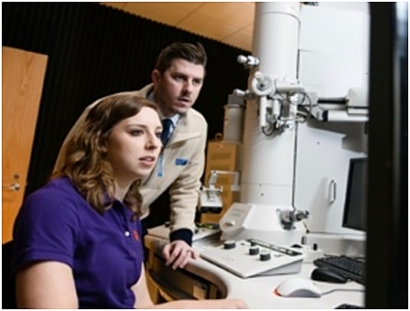
Domhoff, a chemical and biomolecular engineering student, is working to develop nanocomposite materials for batteries that support energy generation at large wind and solar farms. The technology could reduce the cost of renewable energies, thus making them more prevalent in utility portfolios.
“These are like extremely large car batteries, 15 or 20 feet tall. They would store energy produced by wind and solar farms so during the night or when winds aren’t blowing, you could still harvest energy,” said Eric Davis, Domhoff’s faculty adviser and an assistant professor of chemical and biomolecular engineering.
Electron microscopy allows Domhoff to research nanometer-sized particles in the battery’s membrane so she can manipulate its surface chemistries to improve battery life and performance.
Domhoff has presented nationally at meetings of the American Chemistry Society (ACS) and the American Institute of Chemical Engineers (AIChE). She received a prestigious Graduate Research Fellowship from the National Science Foundation and is one of 10 finalists for the national AIChE Excellence in Graduate Polymer Research Award, which will be announced in November.
Domhoff, who expects to graduate in May, hopes to continue her research in the private sector. She earned her undergraduate degree at Duquesne University in Pittsburgh before attending Clemson for Ph.D. studies.
“Clemson has all of the big-school funding and resources, but it’s a relatively small department so you get the one-on-one mentoring and collaboration,” she said.
Hitachi High Technologies America Inc. established the fellowship in 2014. Domhoff is the sixth recipient.
Hitachi High Technologies helped establish the university’s Electron Microscope Facility in the mid-1990s. It has steadily grown with Hitachi’s support and is housed at the Advanced Materials Research Laboratory (AMRL) in Anderson County about 15 minutes from Clemson’s main campus.
In the past year, the Electron Microscopy Facility at Clemson as added some of Hitachi’s most advanced microscopes.
“Our longstanding relationship with Hitachi has provided Clemson faculty and students with one of the nation’s premiere microscopy labs in which to learn and conduct research,” said Tanju Karanfil, Clemson vice president for research.
The facility is also used by the private sector for product development in the state’s automotive, aerospace, medical, electronics, textile and energy industries, among others.
Douglas Hirt, associate dean for research and graduate studies in the College of Engineering, Computing and Applied Sciences, thanked Hitachi High Technologies America Inc. for supporting the college’s students.
“These fellowships help enable our students to conduct cutting-edge research with the help of some of the best electron microscopes in the world,” Hirt said. “I congratulate Allison on winning this year’s fellowship. It is a well-deserved honor and a reflection of the quality of work she is doing under the guidance of Dr. Eric Davis.”
Photo: Clemson University Ph.D. student Allison Domhoff and Eric Davis, assistant professor of chemical and biomolecular engineering, use an electron microscope to analyze nanometer-sized particles.

